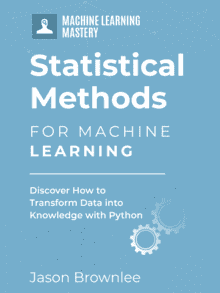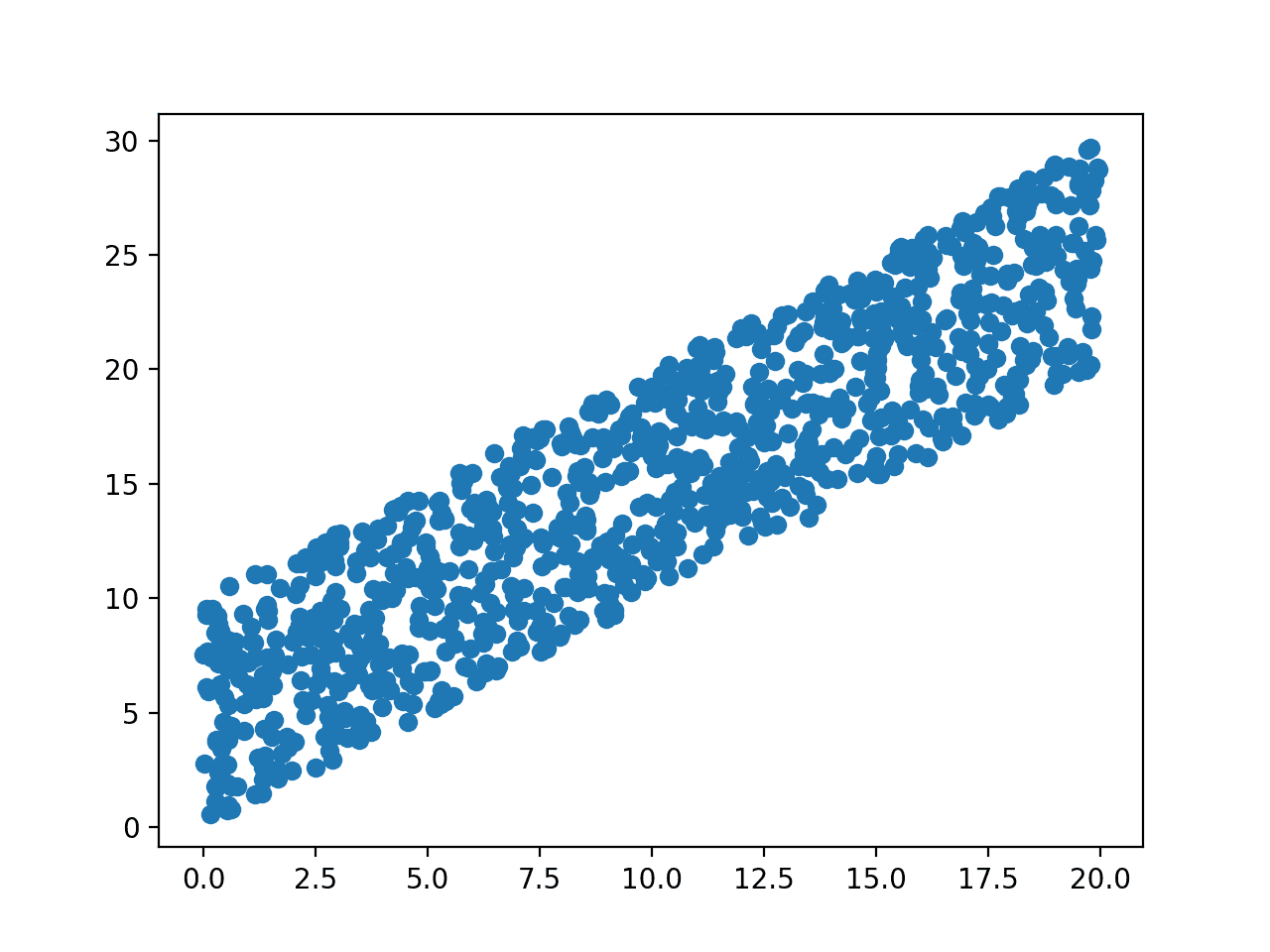In applied machine learning, we often need to determine whether two data samples have the same or different distributions.
We can answer this question using statistical significance tests that can quantify the likelihood that the samples have the same distribution.
If the data does not have the familiar Gaussian distribution, we must resort to nonparametric version of the significance tests. These tests operate in a similar manner, but are distribution free, requiring that real valued data be first transformed into rank data before the test can be performed.
In this tutorial, you will discover nonparametric statistical tests that you can use to determine if data samples were drawn from populations with the same or different distributions.
After completing this tutorial, you will know:
- The Mann-Whitney U test for comparing independent data samples: the nonparametric version of the Student t-test.
- The Wilcoxon signed-rank test for comparing paired data samples: the nonparametric version of the paired Student t-test.
- The Kruskal-Wallis H and Friedman tests for comparing more than two data samples: the nonparametric version of the ANOVA and repeated measures ANOVA tests.
Kick-start your project with my new book Statistics for Machine Learning, including step-by-step tutorials and the Python source code files for all examples.
Let’s get started.
- Updated May/2018: Improved language around reject vs fail to reject of statistical tests.

Introduction to Nonparametric Statistical Significance Tests in Python
Photo by Jirka Matousek, some rights reserved.
Tutorial Overview
This tutorial is divided into 6 parts; they are:
- Nonparametric Statistical Significance Tests
- Test Data
- Mann-Whitney U Test
- Wilcoxon Signed-Rank Test
- Kruskal-Wallis H Test
- Friedman Test
Need help with Statistics for Machine Learning?
Take my free 7-day email crash course now (with sample code).
Click to sign-up and also get a free PDF Ebook version of the course.
Nonparametric Statistical Significance Tests
Nonparametric statistics are those methods that do not assume a specific distribution to the data.
Often, they refer to statistical methods that do not assume a Gaussian distribution. They were developed for use with ordinal or interval data, but in practice can also be used with a ranking of real-valued observations in a data sample rather than on the observation values themselves.
A common question about two or more datasets is whether they are different. Specifically, whether the difference between their central tendency (e.g. mean or median) is statistically significant.
This question can be answered for data samples that do not have a Gaussian distribution by using nonparametric statistical significance tests. The null hypothesis of these tests is often the assumption that both samples were drawn from a population with the same distribution, and therefore the same population parameters, such as mean or median.
If after calculating the significance test on two or more samples the null hypothesis is rejected, it indicates that there is evidence to suggest that samples were drawn from different populations, and in turn the difference between sample estimates of population parameters, such as means or medians may be significant.
These tests are often used on samples of model skill scores in order to confirm that the difference in skill between machine learning models is significant.
In general, each test calculates a test statistic, that must be interpreted with some background in statistics and a deeper knowledge of the statistical test itself. Tests also return a p-value that can be used to interpret the result of the test. The p-value can be thought of as the probability of observing the two data samples given the base assumption (null hypothesis) that the two samples were drawn from a population with the same distribution.
The p-value can be interpreted in the context of a chosen significance level called alpha. A common value for alpha is 5% or 0.05. If the p-value is below the significance level, then the test says there is enough evidence to reject the null hypothesis and that the samples were likely drawn from populations with differing distributions.
- p <= alpha: reject H0, different distribution.
- p > alpha: fail to reject H0, same distribution.
Test Dataset
Before we look at specific nonparametric significance tests, let’s first define a test dataset that we can use to demonstrate each test.
We will generate two samples drawn from different distributions. We will draw the samples from Gaussian distributions for simplicity, although, as noted, the tests we review in this tutorial are for data samples where we do not know or assume any specific distribution.
We will use the randn() NumPy function to generate a sample of 100 Gaussian random numbers in each sample with a mean of 0 and a standard deviation of 1. Observations in the first sample are scaled to have a mean of 50 and a standard deviation of 5. Observations in the second sample are scaled to have a mean of 51 and a standard deviation of 5.
We expect the statistical tests to discover that the samples were drawn from differing distributions, although the small sample size of 100 observations per sample will add some noise to this decision.
The complete code example is listed below.
|
1 2 3 4 5 6 7 8 9 10 11 12 13 |
# generate gaussian data samples from numpy.random import seed from numpy.random import randn from numpy import mean from numpy import std # seed the random number generator seed(1) # generate two sets of univariate observations data1 = 5 * randn(100) + 50 data2 = 5 * randn(100) + 51 # summarize print('data1: mean=%.3f stdv=%.3f' % (mean(data1), std(data1))) print('data2: mean=%.3f stdv=%.3f' % (mean(data2), std(data2))) |
Running the example generates the data samples, then calculates and prints the mean and standard deviation for each sample, confirming their different distribution.
|
1 2 |
data1: mean=50.303 stdv=4.426 data2: mean=51.764 stdv=4.660 |
Mann-Whitney U Test
The Mann-Whitney U test is a nonparametric statistical significance test for determining whether two independent samples were drawn from a population with the same distribution.
The test was named for Henry Mann and Donald Whitney, although it is sometimes called the Wilcoxon-Mann-Whitney test, also named for Frank Wilcoxon, who also developed a variation of the test.
The two samples are combined and rank ordered together. The strategy is to determine if the values from the two samples are randomly mixed in the rank ordering or if they are clustered at opposite ends when combined. A random rank order would mean that the two samples are not different, while a cluster of one sample values would indicate a difference between them.
— Page 58, Nonparametric Statistics for Non-Statisticians: A Step-by-Step Approach, 2009.
The default assumption or null hypothesis is that there is no difference between the distributions of the data samples. Rejection of this hypothesis suggests that there is likely some difference between the samples. More specifically, the test determines whether it is equally likely that any randomly selected observation from one sample will be greater or less than a sample in the other distribution. If violated, it suggests differing distributions.
- Fail to Reject H0: Sample distributions are equal.
- Reject H0: Sample distributions are not equal.
For the test to be effective, it requires at least 20 observations in each data sample.
We can implement the Mann-Whitney U test in Python using the mannwhitneyu() SciPy function. The functions takes as arguments the two data samples. It returns the test statistic and the p-value.
The example below demonstrates the Mann-Whitney U test on the test dataset.
|
1 2 3 4 5 6 7 8 9 10 11 12 13 14 15 16 17 18 |
# Mann-Whitney U test from numpy.random import seed from numpy.random import randn from scipy.stats import mannwhitneyu # seed the random number generator seed(1) # generate two independent samples data1 = 5 * randn(100) + 50 data2 = 5 * randn(100) + 51 # compare samples stat, p = mannwhitneyu(data1, data2) print('Statistics=%.3f, p=%.3f' % (stat, p)) # interpret alpha = 0.05 if p > alpha: print('Same distribution (fail to reject H0)') else: print('Different distribution (reject H0)') |
Running the example calculates the test on the datasets and prints the statistic and p-value.
The p-value strongly suggests that the sample distributions are different, as is expected.
|
1 2 |
Statistics=4025.000, p=0.009 Different distribution (reject H0) |
Wilcoxon Signed-Rank Test
In some cases, the data samples may be paired.
There are many reasons why this may be the case, for example, the samples are related or matched in some way or represent two measurements of the same technique. More specifically, each sample is independent, but comes from the same population.
Examples of paired samples in machine learning might be the same algorithm evaluated on different datasets or different algorithms evaluated on exactly the same training and test data.
The samples are not independent, therefore the Mann-Whitney U test cannot be used. Instead, the Wilcoxon signed-rank test is used, also called the Wilcoxon T test, named for Frank Wilcoxon. It is the equivalent of the paired Student T-test, but for ranked data instead of real valued data with a Gaussian distribution.
The Wilcoxon signed ranks test is a nonparametric statistical procedure for comparing two samples that are paired, or related. The parametric equivalent to the Wilcoxon signed ranks test goes by names such as the Student’s t-test, t-test for matched pairs, t-test for paired samples, or t-test for dependent samples.
— Pages 38-39, Nonparametric Statistics for Non-Statisticians: A Step-by-Step Approach, 2009.
The default assumption for the test, the null hypothesis, is that the two samples have the same distribution.
- Fail to Reject H0: Sample distributions are equal.
- Reject H0: Sample distributions are not equal.
For the test to be effective, it requires at least 20 observations in each data sample.
The Wilcoxon signed-rank test can be implemented in Python using the wilcoxon() SciPy function. The function takes the two samples as arguments and returns the calculated statistic and p-value.
The complete example is below, demonstrating the calculation of the Wilcoxon signed-rank test on the test problem. The two samples are technically not paired, but we can pretend they are for the sake of demonstrating the calculation of this significance test.
|
1 2 3 4 5 6 7 8 9 10 11 12 13 14 15 16 17 18 |
# Wilcoxon signed-rank test from numpy.random import seed from numpy.random import randn from scipy.stats import wilcoxon # seed the random number generator seed(1) # generate two independent samples data1 = 5 * randn(100) + 50 data2 = 5 * randn(100) + 51 # compare samples stat, p = wilcoxon(data1, data2) print('Statistics=%.3f, p=%.3f' % (stat, p)) # interpret alpha = 0.05 if p > alpha: print('Same distribution (fail to reject H0)') else: print('Different distribution (reject H0)') |
Running the example calculates and prints the statistic and prints the result.
The p-value is interpreted strongly suggesting that the samples are drawn from different distributions.
|
1 2 |
Statistics=1886.000, p=0.028 Different distribution (reject H0) |
Kruskal-Wallis H Test
When working with significance tests, such as Mann-Whitney U and the Wilcoxon signed-rank tests, comparisons between data samples must be performed pair-wise.
This can be inefficient if you have many data samples and you are only interested in whether two or more samples have a different distribution.
The Kruskal-Wallis test is a nonparametric version of the one-way analysis of variance test or ANOVA for short. It is named for the developers of the method, William Kruskal and Wilson Wallis. This test can be used to determine whether more than two independent samples have a different distribution. It can be thought of as the generalization of the Mann-Whitney U test.
The default assumption or the null hypothesis is that all data samples were drawn from the same distribution. Specifically, that the population medians of all groups are equal. A rejection of the null hypothesis indicates that there is enough evidence to suggest that one or more samples dominate another sample, but the test does not indicate which samples or by how much.
When the Kruskal-Wallis H-test leads to significant results, then at least one of the samples is different from the other samples. However, the test does not identify where the difference(s) occur. Moreover, it does not identify how many differences occur. To identify the particular differences between sample pairs, a researcher might use sample contrasts, or post hoc tests, to analyze the specific sample pairs for significant difference(s). The Mann-Whitney U-test is a useful method for performing sample contrasts between individual sample sets.
— Page 100, Nonparametric Statistics for Non-Statisticians: A Step-by-Step Approach, 2009.
- Fail to Reject H0: All sample distributions are equal.
- Reject H0: One or more sample distributions are not equal.
Each data sample must be independent, have 5 or more observations, and the data samples can differ in size.
We can update the test problem to have 3 data samples, instead of 2, two of which have the same sample mean. Given that one sample differs, we would expect the test to discover the difference and reject the null hypothesis.
|
1 2 3 4 |
# generate three independent samples data1 = 5 * randn(100) + 50 data2 = 5 * randn(100) + 50 data3 = 5 * randn(100) + 52 |
The Kruskal-Wallis H-test can be implemented in Python using the kruskal() SciPy function. It takes two or more data samples as arguments and returns the test statistic and p-value as the result.
The complete example is listed below.
|
1 2 3 4 5 6 7 8 9 10 11 12 13 14 15 16 17 18 19 |
# Kruskal-Wallis H-test from numpy.random import seed from numpy.random import randn from scipy.stats import kruskal # seed the random number generator seed(1) # generate three independent samples data1 = 5 * randn(100) + 50 data2 = 5 * randn(100) + 50 data3 = 5 * randn(100) + 52 # compare samples stat, p = kruskal(data1, data2, data3) print('Statistics=%.3f, p=%.3f' % (stat, p)) # interpret alpha = 0.05 if p > alpha: print('Same distributions (fail to reject H0)') else: print('Different distributions (reject H0)') |
Running the example calculates the test and prints the results.
The p-value is interpreted, correctly rejecting the null hypothesis that all samples have the same distribution.
|
1 2 |
Statistics=6.051, p=0.049 Different distributions (reject H0) |
Friedman Test
As in the previous example, we may have more than two different samples and an interest in whether all samples have the same distribution or not.
If the samples are paired in some way, such as repeated measures, then the Kruskal-Wallis H test would not be appropriate. Instead, the Friedman test can be used, named for Milton Friedman.
The Friedman test is the nonparametric version of the repeated measures analysis of variance test, or repeated measures ANOVA. The test can be thought of as a generalization of the Kruskal-Wallis H Test to more than two samples.
The default assumption, or null hypothesis, is that the multiple paired samples have the same distribution. A rejection of the null hypothesis indicates that one or more of the paired samples has a different distribution.
- Fail to Reject H0: Paired sample distributions are equal.
- Reject H0: Paired sample distributions are not equal.
The test assumes two or more paired data samples with 10 or more samples per group.
The Friedman test is a nonparametric statistical procedure for comparing more than two samples that are related. The parametric equivalent to this test is the repeated measures analysis of variance (ANOVA). When the Friedman test leads to significant results, at least one of the samples is different from the other samples.
— Pages 79-80, Nonparametric Statistics for Non-Statisticians: A Step-by-Step Approach, 2009.
We can implement the Friedman test in Python using the friedmanchisquare() SciPy function. This function takes as arguments the data samples to compare and returns the calculated statistic and p-value.
This significance test can be demonstrated on the same variation of the test dataset as was used in the previous section. Namely three samples, two with the same population mean and one with a slightly different mean. Although the samples are not paired, we expect the test to discover that not all of the samples have the same distribution.
The complete code example is listed below.
|
1 2 3 4 5 6 7 8 9 10 11 12 13 14 15 16 17 18 19 |
# Friedman test from numpy.random import seed from numpy.random import randn from scipy.stats import friedmanchisquare # seed the random number generator seed(1) # generate three independent samples data1 = 5 * randn(100) + 50 data2 = 5 * randn(100) + 50 data3 = 5 * randn(100) + 52 # compare samples stat, p = friedmanchisquare(data1, data2, data3) print('Statistics=%.3f, p=%.3f' % (stat, p)) # interpret alpha = 0.05 if p > alpha: print('Same distributions (fail to reject H0)') else: print('Different distributions (reject H0)') |
Running the example calculates the test on the three data samples and prints the test statistic and p-value.
The interpretation of the p-value correctly indicates that at least one sample has a different distribution.
|
1 2 |
Statistics=9.360, p=0.009 Different distributions (reject H0) |
Extensions
This section lists some ideas for extending the tutorial that you may wish to explore.
- Update all examples to operate on data samples that have the same distribution.
- Create a flowchart for choosing each of the statistical significance tests given the requirements and behavior of each test.
- Consider 3 cases of comparing data samples in a machine learning project, assume a non-Gaussian distribution for the samples, and suggest the type of test that could be used in each case.
If you explore any of these extensions, I’d love to know.
Further Reading
This section provides more resources on the topic if you are looking to go deeper.
Books
API
- numpy.random.seed() API
- numpy.random.randn() API
- scipy.stats.mannwhitneyu() API
- scipy.stats.wilcoxon() API
- scipy.stats.kruskal() API
- scipy.stats.friedmanchisquare() API
Articles
- Nonparametric statistics on Wikipedia
- Paired difference test on Wikipedia
- Mann-Whitney U test on Wikipedia
- Wilcoxon signed-rank test on Wikipedia
- Kruskal-Wallis one-way analysis of variance on Wikipedia
- Friedman test on Wikipedia
Summary
In this tutorial, you discovered nonparametric statistical tests that you can use to determine if data samples were drawn from populations with the same or different distributions.
Specifically, you learned:
- The Mann-Whitney U test for comparing independent data samples: the nonparametric version of the Student t-test.
- The Wilcoxon signed-rank test for comparing paired data samples: the nonparametric version of the paired Student t-test.
- The Kruskal-Wallis H and Friedman tests for comparing more than two data samples: the nonparametric version of the ANOVA and repeated measures ANOVA tests.
Do you have any questions?
Ask your questions in the comments below and I will do my best to answer.








Thanks for this great article, one query, how do we determine if a sample is following Normal Distribution. In each of these we are comparing two distributions, but how to know if any one of them is Normal dist pls.
Great question, here are a list of methods:
https://machinelearningmastery.com/a-gentle-introduction-to-normality-tests-in-python/
I stopped reading after “Accept H0”.
Thanks, I’ll rework the language.
Thanks for the great article. For right skewed data(like ARPU), would you recommend running u test on the data or running a lot of sampling simulations and running t test on the standard error of the mean (which will have normal distribution). The method described in detail here: http://blog.analytics-toolkit.com/2017/statistical-significance-non-binomial-metrics-revenue-time-site-pages-session-aov-rpu/
Perhaps try it and see?
Hi Yoav,
The simulations in the blog post you reference were simply to illustrate the point of the Central Limit Theorem (proven a long time ago) which holds very well even for relatively small sample sizes (30-40 observations per group) according to sims I’ve done. You can apply a t-test to each particular case without any simulations whatsoever.
Furthermore, a non-parametric test like the Mahn-W Rank test will only evaluate the same thing as a t-test (difference in mean or median) only when the t-test assumptions hold, otherwise it is a test for stochastic difference and it harder to interpret and communicate.
Best,
Georgi
Hi Jason, thanks for the enlightening post. I was thinking whether I can apply the Wilcoxon test for two sets of data, each is the measurement of the same variable, but one is through an instrument and the other is through a model. They are time series data and paired hourly.
The possible auto correlation across time intervals might make it a problem.
Perhaps check with a statistician/
You great helper, You!
Man, I don’t know how you do it – and just create all these pertinent topics that address my multifaceted data science needs. But thank you Jason Brownlee. Thank you!
Thanks, I’m happy they help!
Interesting article!
I am running a comparison of two different machine learning methods on the same dataset for a number of 30 seeds. So I get 30 AUC for each of the methods.
Is the The Wilcoxon signed-rank test a good method to compare these two methods?
Hmmm, maybe a Student’s t test:
https://machinelearningmastery.com/statistical-significance-tests-for-comparing-machine-learning-algorithms/
If its critical to the project, check in with a statistician.
Why do you using only p-value? The stat value does,nt matter? There is no t-table like for comparing?
The p-value is an interpretation of the critical value (stat value).
After carefully documentation reading, I use r2py and port the stats.wilcox.test() from R to Python due to approximation errors and normal approximations. The scipy version only returns the two-sided values and does not implement the less and greater alternative hypothesis. There are also problems with the small number of tests (less than 20) that is the 10-fold cross-validation case.
Thanks for sharing.
I find the following extremely misleading:
Fail to Reject H0: Sample distributions are equal.
These tests never conclude that the distributions are equal, but simply that we cannot say for sure that they are not equal. Failure to reject could be motivated simply by low power, which is to say: your distributions may be different, but with the amount of data you have, we cannot be sure.
Yes, you are correct. I was aiming to provide a simplified interpretation for common usage.
Instead, we could say “sample distributions are likely drawn from the same population”.
Hi Jason,
Great tutorials. I have few questions as i don’t have a statistics background:
1. I am using classifiers performance scores (such as accuracy) as sample distribution from each of 10-folds (CV test scores). Am i doing it correctly?
2. Is a non-parametric test most suitable in my case?
Great question!
I recommend reading this post on this exact topic:
https://machinelearningmastery.com/statistical-significance-tests-for-comparing-machine-learning-algorithms/
Hi Jason,
thanks for the amazing tutorial.
I was wondering how to do a post-hoc Bonferroni correction (after performing Kruskal-Wallis test) in order to get which groups are statistically different.
I already did it in Matlab using the following function:
[results,means] = multcompare(stats,’CType’,’bonferroni’)
where ‘stats’ is the value taken from Kruskal-Wallis test.
Thank you in advance.
Not sure off hand, sorry. Perhaps check the API to see if it is offered, or perhaps try implement it yourself in Python?
https://en.wikipedia.org/wiki/Bonferroni_correction
Hi Jason,
Thank you for a nice post. Are there any algorithms that can divide an existing (e.g. skewed) distribution into 2-3 distributions that use e.g. the Mann-Whitney U Test to verify that they are from the same distribution?
I am thinking e.g. when dividing data sets for training neural networks, when we want the training, validation and test sets to be similar.
I don’t know about dividing a sample and then using a test on it. Why not use the test on it directly.
Thanks for the super clear explanation,
Just a small comment, I think the test is actually used for small samples (<20) when you have a larger # of points, it just behaves like normal dist with known parameters (see wikipedia for details), so I think you should perhaps remove that requirement from this wonderful text.
cheers!
Thanks for sharing!
Hi Jason,
A very informative article, helped me learn a lot!
Is there a way to calculate the confidence interval for the Wilcoxon signed-rank test in python? I could see an easy R implementation but nothing in python. Any pointers?
Thanks
Thanks!
Sorry, I don’t have an example.
No worries Jason. It led me to dig deeper to look for a solution and eventually I found one.
Since nothing out of the box was available in python, I followed the research and created a small function. I decided to write an article around the solution so that others could use it if required and I have mentioned you in credits as this post was one of reasons I started thinking about it.
Your expert opinions on the solution would be great to have, in case you get the chance to have a look at it, anytime in future : https://towardsdatascience.com/prepare-dinner-save-the-day-by-calculating-confidence-interval-of-non-parametric-statistical-29d031d079d0
Thanks
Well done!
While i contain the categorical data, would i convert it to numerical data and use Mann-Whitney U Test ?
That does not sound appropriate, consider a chi squared test for categorical data:
https://machinelearningmastery.com/chi-squared-test-for-machine-learning/
What is it that we have to do if we are having a pair of samples(A and B) with two dimensional data(‘x’ rows and ‘y’ columns)?
I am trying to train an ML model with the sample A and then test the model with a different sample B. I am trying to understand how statistically different are the two samples and see if model is actually good or it needs re-training.
Good question, and tough to answer.
One approach might be to look at each pair of variables and see if they differ between the samples, or each pair of input variable with target and if they differ between samples. The latter sounds appropriate.
Hello,
Thanks a lot for your informative blog!
Can I use Python wilcoxon for “unequal N” ?
Regards,
– Mahmoud Sabri
Thanks.
Wilcoxon is a paired test. Off the cuff I would say no. Perhaps you can dig into the literature to confirm.
Hi Jason, thanks as always for the great blog posts! Do you have any guidance on how to calculate an effect size for these tests (especially Kruskal-Wallis) in python? Thanks!
This might help as a first step:
https://machinelearningmastery.com/effect-size-measures-in-python/
Hi Jason, thank you very much for the great tutorial. I need your guidance regarding a small confusion. I am testing the performance of 5 different classifiers on 10 datasets (by increasing the size). I have a table of accuracy values for classifiers (rows) and datasets (columns). I want to use the Friedman test to check if there is significant difference among the performance of the classifiers. Should i pass the rows (5 samples) or columns (10 samples) to the friedmanchisquare function?
The sample of scores for each algorithm on one dataset would be provided to the function.
Hello,
Thanks for this great overview. I am performing a Friedman Test.
I get a p-value of 0.000 and ‘Different distribution (reject H0)’
I would like to know, if I can access the complete p-value.
Thanks for your help.
Yes, it is returned from the function directly.
Hi Jason, thanks for the article, if there are two paired non-parametric samples, with different sizes, which test could be applied to compare the mean please? it is exactly the same case as the wilcoxon signed rank test, but wilcoxon signed rank test can be only applied to compare two samples datasets with the same size.
If the samples are not paired, consider the Mann-Whitney U.
Hi Jason, thanks, that is the problem, because the samples are paired, dependent. I also don’t find a test, that can be applied to such a scenario… Thank you anyway.
If the samples are paired, you will have the same number in each sample and can use “Wilcoxon Signed-Rank Test”.
I understand that mannwhitneyu takes in large sample sizes only. Hence, does it already use a normal distribution to approximate the test statistic?
No it does not, it is a rank based method.
Great article! Question on interpreting the data. Let’s say you run a Wilcoxon signed-rank test for paired data and the Null Hypothesis of the distributions A and B being from the same population is rejected. Is it valid to say that since the distributions A&B are different (per the test), that the distribution with the lower mean (say A) is part of a population that has an overall lower mean than the population distribution B belongs to? If that is not valid, how would you set up a test to validate that?
Thanks!
If the null is reject, the samples are probably from different populations, e.g. have different distributions.
We can’t say much about the mean of the samples/distributions, as they are rank tests.
Always liked your articles and have been following your site for years and I know many people do.
Just a question – this condition seems right but I am not sure why it is not generating the correct answer.
if p > alpha:
print(‘Same distributions (fail to reject H0)’)
else:
print(‘Different distributions (reject H0)’)
For example – the p-value is definitely < than 0.05, then this means we cannot reject Ho. But the result will print reject H0.
Statistics=9.360, p=0.009
Different distributions (reject H0)
Thanks!
Perhaps there is a bug/typo in your code, confirm your p and alpha values prior to the condition.
Thanks, what can we do when we are dealing with two extremely skewed distributions (let’s say it’s an A/B test) and more than 95 of the observations in each group is zero and the other are right tailed (like salaries or purchase amount. Here, when I simulate results it’s really rare to reject the null hypothesis when the means of each sample are different but not so far from each other (Man-Whitney test)
I am not sure this is correct but when you say extremely skewed, it sounds to me that it is not Gaussian. Most statistics would like Gaussian, or at least approximate to it. So one idea might be to transform the data before applying the test. Take log, for example, is a common trick.
Great article! Thank you. Are there any nonparametric tests to determine whether two arrays are drawn from the same population which requires less than 20 samples?
Hi Elizabeth…You may find the following of interest:
https://machinelearningmastery.com/parametric-and-nonparametric-machine-learning-algorithms/
“Friedman test can be thought of as a generalization of the Kruskal-Wallis H Test to more than two samples”, shouldn’t it be generalization of Wilcoxon Signed Rank test?
PS- great article, very helpful
Thank you for the feedback! You could be correct…what is the basis for the question?
I’m working whit data from Fire Brigade. This dataset’s has a lot of information like date, brigade code, and time measure spent to reach the fire site by brigade / occurrence.
I would like compare the means time measure spent to reach the fire site and find what brigade spends more time and less time. This information is to understand the infrastructure among brigades to improve then. There is not a normally distribution among time spent / brigade.
I made some non-parametric tests and found that had differences among time spent / brigades and my question is: which test could I use to know which means is greater than other?
Hi Sandra…I am not able to speak to the dataset you are considering. Do you have any specific questions regarding the code listings or concepts presented in the tutorial?
Hi James,
Do you know if the Wilcoxon test can be used as a non-parametric alternative to one-sample t-test? I have five ROC AUC values (from 5-fold CV) and I want to test if the median AUC is not 0.5. In this case, “x” would be the AUC values and y would be [0.5, 0.5, 0.5, 0.5, 0.5]. Does it make sense for you?
Thank you for sharing your knowledge with us!
Best.
Hi Luiz…You may find the following discussion of interest:
https://stats.stackexchange.com/questions/387152/wilcoxon-signed-rank-test-or-one-sample-t-test
Thank you, James.
For the Kruskall Wallis test, what do we do if the distribution/shape of the data within each group of the independent variable is different ? I read that you can’t compare the median because of that and should look at the mean instead. But the scipy implementation of Kruskall Wallis doesn’t let us choose between the mean and median.